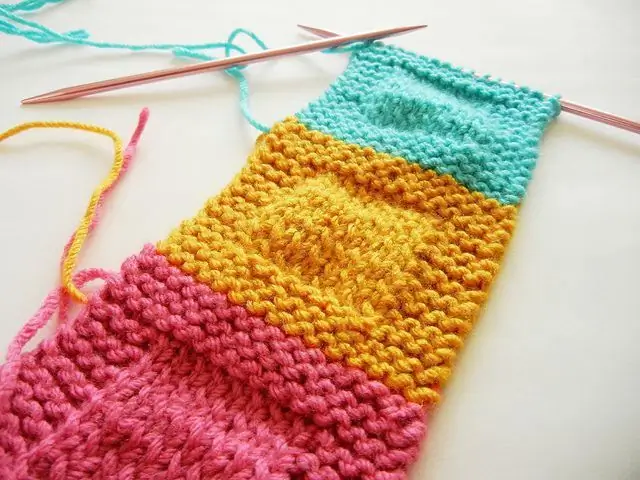
Inhaltsverzeichnis:
- Autor Sierra Becker [email protected].
- Public 2024-02-26 04:44.
- Zuletzt bearbeitet 2025-01-22 22:11.
Viele Nadelfrauen interessiert die Frage: "Wie verbinde ich zwei Strickteile unsichtbar?" Ja, gleichzeitig, damit es nicht schief oder eng wird und das Produkt einfach umwerfend aussieht.
Eigentlich ist das gar nicht kompliziert. Und aufgrund der Tatsache, dass es viele Nähtechniken gibt, können Sie eine bequemere auswählen. In diesem Artikel beschreiben wir verschiedene Möglichkeiten, Strickteile zu verbinden.
Ein paar Feinheiten bei den Nähten
Bevor du mit dem Nähen der Teile beginnst, musst du zuerst alles vorbereiten, was du brauchst. Dies ist zunächst ein Faden, mit dem wir zahlreiche und verschiedene Details nähen werden. Und von den Werkzeugen - eine dicke Nadel mit großem Öhr, Stricknadeln oder ein Haken (je nachdem, welche Nähmethode Sie gewählt haben). Was den Faden betrifft, so verwenden sie meistens denselben, mit dem die Details selbst gestrickt wurden, oder eine ähnliche Farbe. Hauptsache der Faden ist stark.

Beginnen Sie mit dem Nivellieren der Kanten der Teile. Probieren Sie das Produkt dann an und markieren Sie die Nähte. Der Einfachheit halber können Sie zunächst mit einem Faden einer anderen Farbe heften. Nehmen Sie beim Nähen keinen zu langen Faden - das kann esschnell brechen und fest anziehen.
Damit die Naht gleichmäßig und gerade wird, müssen Sie den Faden in Schlaufen ziehen, die sich im gleichen Abstand befinden. Wenn Sie Manschetten oder einen Kragen mit Revers nähen, müssen in diesem Fall die Kanten auf der anderen Seite der gestrickten Teile gemacht werden.
Matratzenstich
Wenn dich vor allem die Frage beschäftigt, wie man gestrickte Teile unauffällig verbindet, dann ist diese vertikale unsichtbare Naht genau das Richtige für dich.
Um es auszuführen, solltest du einen dünnen Faden wählen. Vielleicht sogar Nähen. Es ist notwendig, eine Matratzennaht auf der Vorderseite der Teile auszuführen. Dazu müssen Sie die Kanten verbinden, indem Sie die Kantenschlaufen auf beiden Seiten greifen.
Um die Vorderseite auszuführen, führen wir eine Nadel mit einem Faden ein, zuerst zwischen der ersten und zweiten Schlaufe eines Teils und dann auf dem zweiten Teil. Also nähen wir bis zum Ende. Um die falsche Seite wieder auf der Vorderseite auszuführen, führen wir die Nadel in die Schlaufen selbst ein. Gleichzeitig erfassen wir den oberen Teil der Schleife von einem Teil und den unteren Teil von dem anderen. Wieder bis zum Ende nähen.

Strickmasche
Diese unsichtbare Naht wird verwendet, um Teile zu verbinden, die in der gleichen Richtung verbunden sind. Legen Sie sie zuerst mit der Vorderseite nach oben und den Kanten zueinander. Als nächstes führen Sie die Nadel und den Faden unter der nächsten Schlaufe auf der zweiten Seite durch. Wir nähen analog weiter. Wir haben eine horizontale Stricknaht.
Eine andere Art von gestrickter Masche ist eine Schlaufe-an-Schlaufe-Masche. Es wird verwendet, wenn Sie die Details der Strumpfart des Strickens verbinden müssen. DafürNähen Sie die offenen Schlaufen der beiden Teile des Produkts. Es wird derselbe Faden verwendet, der beim Stricken verwendet wurde.
Fädeln Sie die Nadel mit dem Faden in die erste Schlaufe von der Innenseite des oberen Teils des Produkts ein, ziehen Sie sie in die erste Schlaufe des unteren Teils und führen Sie sie durch die zweite Schlaufe der linken Seite des unteren Teils. Als nächstes fädeln wir den Faden von der Vorderseite des Oberteils in die erste Schlaufe und führen das zweite Oberteil von innen durch. Als nächstes fädeln wir die Nadel von vorne in die zweite Schlaufe des Unterteils ein und führen von innen zum dritten Unterteil. Wir nähen analog weiter. Versuchen Sie, die Nahtschlaufen in der Größe identisch mit den Schlaufen des Produkts zu h alten.
Stich "Kette"
Diese Naht eignet sich zum Verbinden der Schultern. Beim Stricken müssen an den Stricknadeln auf der Vorder- und Rückseite des Produkts freie Maschen gelassen werden. Als nächstes f alten Sie die Teile von innen nach außen zueinander. Wir nehmen eine andere Stricknadel und beginnen, die erste Masche der Rückseite der Vorderseite und dann die zweite Masche von beiden Stricknadeln zu stricken.
Wir beginnen, die Maschen zu schließen, wenn zwei Maschen auf der rechten Stricknadel verbleiben. Wir tun dies, indem wir die erste Schleife auf die zweite werfen. Wir fahren analog bis zum Ende fort. So sehen wir auf der Vorderseite des Produkts ein Muster in Form einer Kette. Diese Art des Nähens eignet sich für diejenigen, die lernen möchten, wie man gestrickte Teile schön verbindet.

Wenn Sie nicht möchten, dass diese Kette sichtbar ist, tun Sie dasselbe, f alten Sie zunächst nur die Teile, die einander zugewandt sind.
Naht mit Verschlussschlaufen
Dies ist eine weitere Möglichkeit für diejenigen, die suchen, wie man gestrickte Teile mit Stricknadeln verbindet. Wir werden diese Naht mit ausführenfalsche Seite des Produkts. Nehmen Sie dazu eine zusätzliche Stricknadel und fädeln Sie diese in die erste vordere Masche der oberen Stricknadel und in die erste linke Masche der unteren Stricknadel ein. Entfernen Sie dann beide Schlaufen. Als nächstes ziehen Sie die zweite Schlaufe durch die erste. Dann wiederholen wir alles von vorne.
Drehen Sie das gestrickte Produkt um und entfernen Sie zwei Schlaufen. Ziehen Sie die zweite durch die erste. Entferne wieder zwei Schlaufen und ziehe die zweite durch die erste. Am Ende befestigen wir die letzte Schlaufe.
Stiche "Nadelrücken"
Auch diese Naht wird von innen nach außen gearbeitet. Wir nehmen beide Teile, f alten sie einander gegenüber und befestigen den Faden an den äußersten Schlaufen. Dann fädeln wir Nadel und Faden ein und ziehen uns einen halben Zentimeter von der letzten Masche zurück.

Führe die Nadel an der Stelle ein, wo die vorherige Masche endet, und führe sie einen halben Zentimeter von der Masche entfernt wieder heraus. Ziehen Sie den Faden heraus. Wir machen genauso weiter.
Häkelstich
Lassen Sie uns ein paar Beispiele beschreiben, wie man gestrickte Teile häkeln kann.
- Wie häkelt man gestrickte Teile? Versteckte Naht. Wir machen es am Rande. Wir legen die beiden Teile des Produkts einander gegenüber und ziehen den Haken durch sie, greifen und ziehen die Schlaufe. Wieder fädeln wir den Haken ein und ziehen beide Teile und die zuvor erfasste Schlaufe durch. Wir stricken und wiederholen die letzte Aktion bis zum Ende.
- Einzelne Häkelarbeit. Wir machen es auf der Vorderseite des Produkts. Wir führen den Haken durch die Wände der geschlossenen Reihe beider Teile und ziehen den Faden heraus, indem wir den Faden greifen. Ziehen Sie die Schlaufe durch die nächsten beiden Schlaufen der geschlossenen Reihe und greifen Sie den Faden und ziehen Sie ihn herauseine neue Schleife durch die beiden vorherigen am Haken. Dann fahren wir im selben Muster fort, ab dem Moment, in dem die erste Schlaufe gezogen wird.
- Um die offenen Maschen der Stricknadeln zu verbinden, beide Teile einander zugewandt f alten und die Häkelnadel durch die ersten Maschen der Stricknadeln fädeln und wie bei den vorderen entfernen. Dann einen Faden über die Häkelnadel ziehen und eine Schlaufe durch zwei Schlaufen auf der Häkelnadel ziehen. Entfernen Sie nun 2 Maschen von den Stricknadeln. Am Haken verbleiben drei Schlaufen. Garn über die Häkelnadel fädeln und eine Schlaufe durch die drei Schlaufen auf der Häkelnadel ziehen. Jetzt ist noch 1 Schlaufe am Haken übrig, und wir wiederholen alle Schritte ab dem Moment, an dem der Haken zwei Schlaufen von den Stricknadeln entfernt hat.
Nähstich
Wie verbindet man Strickteile mit Stricknadeln? Um die Naht unsichtbar zu machen, müssen Sie sie von innen nach außen ausführen. Wenn Sie jedoch eine dekorative Schnürnaht an der Verbindungsstelle der Teile wünschen, können Sie dies von der Vorderseite aus tun.

Wir legen die beiden Teile des Produkts einander zugewandt zusammen und platzieren die Kanten auf derselben Linie. Dann führen wir eine Nadel mit einem Faden von hinten durch die Engstellen zwischen den Schlaufen an den Rändern. Wir nähen es zu Ende.
Verbindung von vertikalem und horizontalem Teil
Am häufigsten wird dieser Stich zum Nähen von Ärmeln verwendet. Falls es mehr Reihen als Schlaufen gibt, greifen Sie beim Annähen eines Ärmels regelmäßig zwei Räumnadeln zwischen die Schlaufen der Kante eines Teils und eine Schlaufe des anderen.

Beim Strumpfstricken vertikal und horizontal verbindenTeile, ist es notwendig, die Nadel mit dem Faden in einer geschlossenen Reihe unter die Schlaufe des vertikalen Teils zu führen und sie unter die Ahle zwischen der ersten und zweiten Schlaufe des horizontalen Teils zu bringen. Und dann nähen wir nach demselben Muster bis zum Ende.
Das ist alles, nichts Kompliziertes, wie man gestrickte Teile schön verbindet. Sie müssen nur anfangen, und das Stricken wird Sie in die Welt der Magie ziehen!
Empfohlen:
Wie man Slingo-Perlen mit eigenen Händen bindet. Wie man Slingo-Perlen häkelt
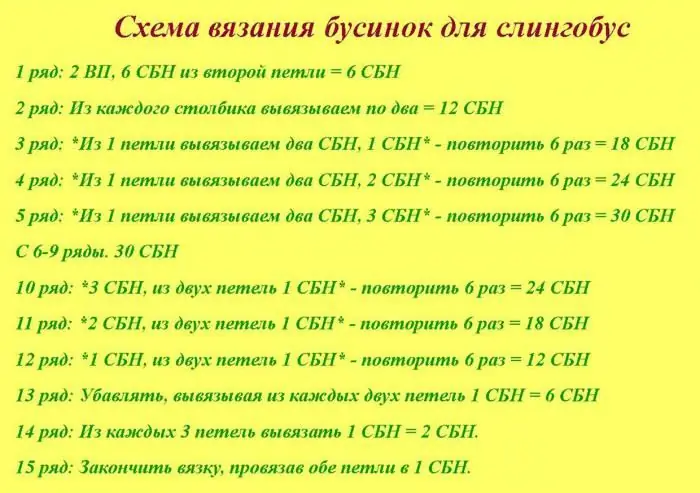
Heute ist es sehr in Mode gekommen, Schleuderbusse mit eigenen Händen herzustellen. Diesen süßen Mumienschmuck, den sie gerne wie gewöhnliche Perlen um den Hals trägt, können Babys zum Spielen oder sogar zum Kratzen des Zahnfleisches beim Zahnen verwenden
Temari-Kugeln, wie man sie macht? Wie man einen Temari-Ball stickt
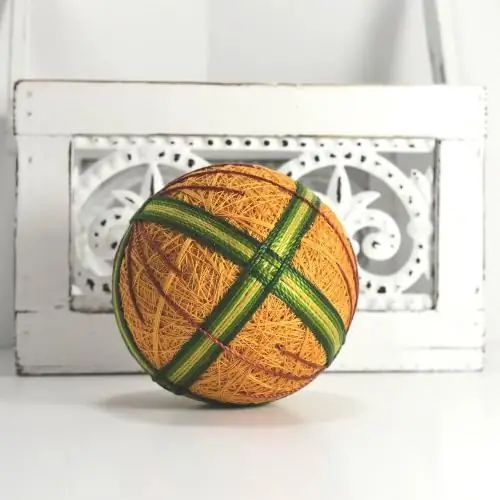
Die Kunst von "Temari" ist das Sticken von leuchtenden Mustern auf Bälle. Muster können einfach oder abstrakt sein, mit Formen, die sich in verschiedenen Winkeln schneiden (Dreiecke, Rauten, Ovale, Quadrate, Ellipsen usw.). Dies ist eine sehr lustige und entspannende Handarbeit, die Sie zu Hause, vor dem Fernseher oder auf einer Reise machen können
Wie man mit eigenen Händen einen Stuhl baut. Wie man mit eigenen Händen einen Schaukelstuhl baut
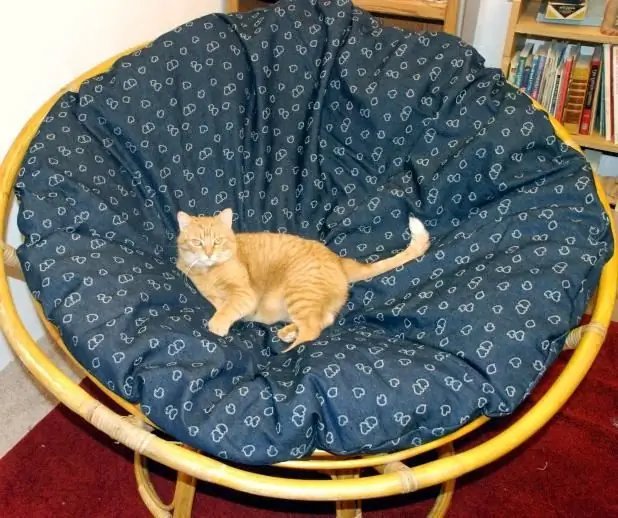
Möbel können nicht nur aus Brettern hergestellt werden, sondern aus jedem verfügbaren Material. Die Frage ist nur, wie stark, zuverlässig und langlebig es sein wird. Überlegen Sie, wie Sie aus Plastikflaschen, Pappe, Weinkorken, Reifen und Faden einen Stuhl mit Ihren eigenen Händen herstellen können
Wie bringt man einem Kind das Schachspielen bei? Figuren im Schach. Wie man Schach spielt: Regeln für Kinder
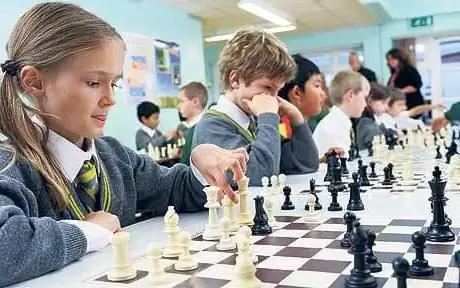
Viele Eltern möchten ihr Kind sowohl körperlich als auch geistig entwickeln. Für das zweite ist ein altes indisches Spiel großartig. Und im Zusammenhang mit diesen Bedingungen stellen sich Eltern zunehmend die Frage: "Wie bringt man einem Kind das Schachspielen bei?"
Puzzle wie man 9 Punkte mit 4 Linien verbindet und ähnliche Aufgaben
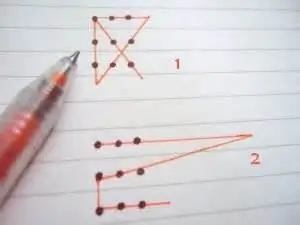
Nicht standardmäßig in seiner Argumentation, das Problem, wie man 9 Punkte mit 4 Linien verbindet, bringt Sie dazu, Stereotypen zu brechen und Kreativität zu aktivieren
